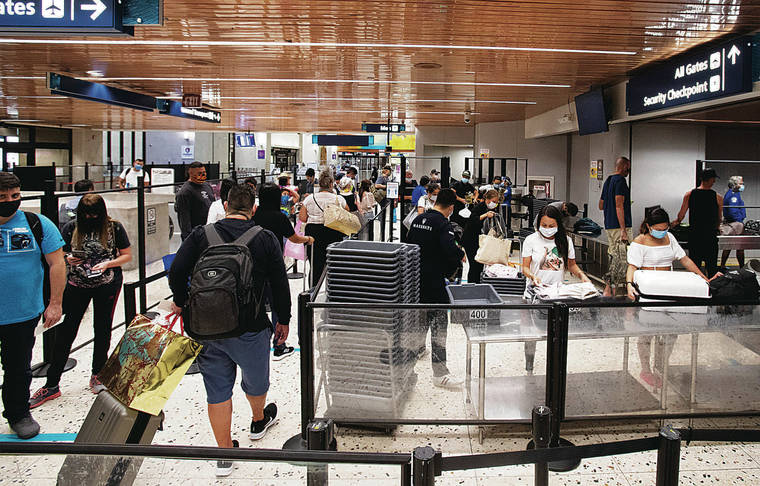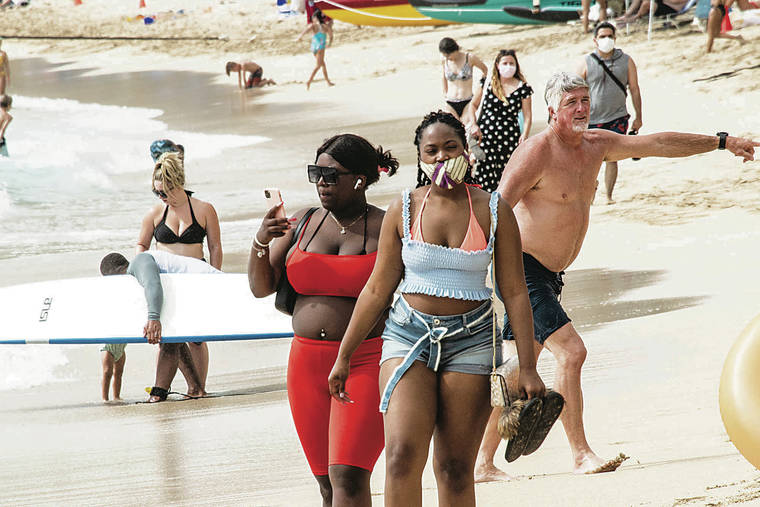Kauai wants stricter travel entry rules

CINDY ELLEN RUSSELL / CRUSSELL@STARADVERTISER.COM
A TSA agent looked back Sunday at a group of travelers passing through the Terminal 1 security checkpoint at Daniel K. Inouye International Airport.

CRAIG T. KOJIMA / CKOJIMA@STARADVERTISER.COM
Visitor Sabrina Ferreira took a photo Sunday of her son Matthew Santos and daughter Luanna Santos in front of the Duke Kahanamoku statue in Waikiki. Ferreira and her son are from Arizona, and her daughter is from Florida.

CINDY ELLEN RUSSELL / CRUSSELL@STARADVERTISER.COM
Travelers passed through the Terminal 1 security checkpoint Sunday at Daniel K. Inouye International Airport.

CRAIG T. KOJIMA / CKOJIMA@STARADVERTISER.COM
New Yorkers Aissatou Bah, left, and Luci Kone walked along Waikiki Beach on Sunday.




Kauai health officials have reported 22 more COVID-19 cases, at least 19 of them travel-related, since Nov. 16 when Mayor Derek S.K. Kawakami sought additional requirements for travelers coming to the Garden Island.
The state Health Department’s tally for Kauai differs at 17 cases from Nov. 16 to Sunday. State health officials on Sunday reported 123 new coronavirus infections statewide and two new deaths on Oahu, bringing the totals since the start of the pandemic to 17,220 cases and 233 fatalities.
Sarah Blane, Kauai County spokeswoman, said Kauai reports cases as they are confirmed, so it is usually 24 to 48 hours ahead of the state reports.
Sunday’s new infection cases in Hawaii include 97 on Oahu, 14 on the Big Island, six on Kauai, four on Maui and two Hawaii residents diagnosed outside the state, according to the Health Department. The statistics released Sunday reflect the new cases reported to the department through 11:59 p.m. Friday.
Hawaii had the nation’s lowest rate of COVID infections on Sunday despite another triple-digit increase in coronavirus cases and two more deaths. There was an average of 5.7 COVID-19 cases per every 100,000 people. The U.S. coronavirus death toll was more than 256,000 Sunday as the nation surpassed 12 million cases.
It was against this backdrop of already surging cases in the U.S. and on Kauai that Kawakami asked Gov. David Ige to consider two new county emergency rules that would tighten travel entry requirements for Kauai.
Don't miss out on what's happening!
Stay in touch with breaking news, as it happens, conveniently in your email inbox. It's FREE!
Kawakami did not immediately respond to a request for comment from the Honolulu Star-Advertiser.
At the time of Kawakami’s request to Ige, Kauai health officials already had reported 26-travel-related cases, including 14 involving returning residents.
“A month into the state’s Safe Travels program, it is clear that a single pre-travel test is not sufficient to protect us from the spread of COVID-19. Our cases are increasing much faster than initial state projections,” Kawakami said Nov. 16.
Ige has the power to overrule county restrictions. However, Ige has indicated from the start of the pre-arrival testing program that his preference is to empower the counties, so he likely wouldn’t prevent them from opting out of Safe Travels Hawaii.
“One of the reasons that we do allow counties to implement different programs is because the health care system in each island is very different,” Ige told the Star-Advertiser during an Oct. 16 interview. “For example, Kauai only has nine ICU beds, and clearly any kind of outbreak would have significant impact on the capacity of that island to respond. I’ve had lots of conversations with Mayor Kawakami, and I share his concern and we are monitoring those numbers every single day.”
Steve O’Neal, a former U.N. Disaster Response Team lead living on Kauai, said in an email that Ige and Lt. Gov. Josh Green have stated that community spread is the main problem on all islands. However, O’Neal said that this is not the case on Kauai, where virtually all cases have been traveler-related.
“Kauai, with 72,000 citizens, is the last community in the United States with little or no community spread, and one of the last of its size in the world. On a per capita basis we had fewer cases than New Zealand on October 14th,” O’Neal said in an email. “Yet if the state’s opening policies continue, we will have squandered that gift.”
Kawakami has asked Ige to approve Emergency Rule No. 21, which would require interisland and trans-Pacific participants in the Safe Travels pre-arrival testing program to quarantine for 72 hours and then take a post-arrival test. They would stay in quarantine until obtaining a negative test result.
Ige, who did not approve a similar request from Kawakami in September, is unlikely to approve Kawakami’s latest testing-related rule change.
Ige also isn’t likely to approve Kawakami’s Emergency Rule No. 22 , which would require all travelers to have their negative test results uploaded to the Safe Travels program prior to flying to Kauai. Should test results not be available upon arrival, a 14-day quarantine would be required.
However, on Thursday Ige did issue an emergency proclamation requiring that trans-Pacific travelers must have their COVID-19 test results — from a trusted testing partner — prior to departing to Hawaii if they wished to bypass the 14-day quarantine.
Ige’s latest proclamation, while similar to Kauai’s Rule No. 22, doesn’t apply to interisland travelers, a provision that Kauai wants.
Kawakami has acknowledged that his proposed rule changes could prove frustrating for travelers and visitor industry members. But he said in his statement, “The outbreak of COVID-19 across the nation is occurring at a faster rate than we’ve ever seen before. We have the unique opportunity to see the wave of disease coming, and in order to avoid a full shutdown, we must take decisive, aggressive action.”
On Oct. 13, Ige approved Kawakami’s four-tiered reopening system for Kauai, which doesn’t allow for much COVID-19 spread on Kauai before the county imposes restrictions on business and travel, including possibly opting out of the state’s pre-arrival testing program.
Tier 4, Kauai’s least restrictive tier, requires an average of less than two daily active cases. It allows nearly all businesses and activities to operate with minimal restrictions and the county to participate in the state’s 72-hour pre- arrival test program to allow trans-Pacific travelers an opportunity to bypass the state’s 14-day mandatory quarantine.
A weekly average of two to four daily COVID-19 cases could take Kauai to Tier 3. At this level trans- Pacific travelers still may pre-test out of quarantine, per the state’s travel plan. However, Kauai would likely see further limits on gatherings and receptions.
Tier 2 assumes that Kauai’s seven-day average of COVID-19 cases is between five and eight. Moving into this tier would trigger the process to opt out of the state’s pre-travel testing program and continue a 14-day mandatory quarantine for incoming travelers.
Tier 1, the most restrictive tier, goes into effect if there is a one-week average of eight or more daily COVID-19 cases. At that point Kauai would not allow any pre-testing quarantine exemptions.
Blane said Kawakami could make a decision on Kauai’s tier movement during the first week of December.
“At a rate of 1-2 cases, it could be as early as the first week of December. But the past few days the rate has spiked to 4-5,” she said. ” If that rate remains consistent, it could trigger us to move directly to Tier 2.”



